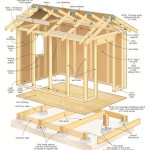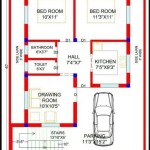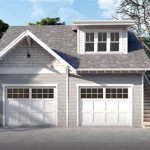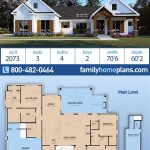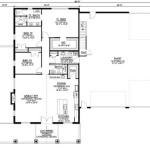House Floor Plans: Optimizing 1600 Square Feet
Designing a home requires careful consideration of space, functionality, and aesthetic appeal. For many homeowners, a 1600 square foot house represents a sweet spot – large enough to accommodate a family comfortably, yet manageable in terms of construction, maintenance, and cost. This article explores the considerations involved in developing effective floor plans for homes of this size, focusing on key design principles and common layout options.
When working with a 1600 square foot footprint, prioritizing efficient space utilization is paramount. Every square inch needs to be thoughtfully planned to maximize livability and minimize wasted areas. This necessitates a strategic approach to the arrangement of rooms, hallways, and storage solutions.
Defining Functional Zones
A crucial first step in designing any home floor plan is to define distinct functional zones. These zones typically include living/social areas, private/sleeping areas, and service areas. The living/social area typically encompasses the living room, dining room, and kitchen, which are often integrated to foster a sense of openness and connectivity. The private zone houses bedrooms and bathrooms, designed for relaxation and privacy. The service zone includes areas like the laundry room, mudroom, and potentially a home office, addressing practical needs and storage.
The placement and interconnection of these zones greatly impact the overall flow and functionality of the house. For example, locating the bedrooms away from the main living area can minimize noise disturbance. A well-positioned mudroom near the entrance can help contain clutter and maintain cleanliness. The kitchen's location should optimize access to both the dining area and outdoor spaces, if applicable.
Open-concept layouts are particularly popular in modern home design, particularly within the living/social area. This approach eliminates or minimizes walls between the kitchen, living room, and dining room, creating a spacious and airy feel. However, careful consideration must be given to defining distinct areas within the open space through furniture arrangement, changes in flooring, or subtle architectural details like partial walls or columns.
Maximizing Space Efficiency
Several strategies can be employed to maximize space efficiency in a 1600 square foot house. One of the most effective is to minimize hallway space. Hallways, while necessary for circulation, consume valuable square footage that could be allocated to more usable living areas. Open floor plans and strategic placement of rooms can reduce the need for lengthy hallways.
Another key factor is the incorporation of built-in storage solutions. Built-in bookshelves, cabinets, and window seats not only provide ample storage space but also integrate seamlessly into the design, minimizing the need for bulky freestanding furniture. Under-stair storage is another often-overlooked opportunity to gain valuable space.
Consideration should also be given to the size and layout of individual rooms. Oversized rooms may seem desirable, but they can actually detract from the functionality of a smaller home if they leave insufficient space for other essential areas. Optimizing the dimensions of each room based on its intended purpose is crucial. For example, a guest bedroom might be designed with minimal space to accommodate a bed and a small dresser, while prioritizing space in the master suite.
The design of bathrooms and kitchens also plays a significant role in space efficiency. Compact fixtures, such as wall-mounted toilets and corner sinks, can save valuable space in smaller bathrooms. In the kitchen, a well-organized layout with ample counter space and storage is essential for efficient meal preparation. Multi-functional islands can provide additional workspace and storage, while also serving as a breakfast bar or casual dining area.
Common Floor Plan Layouts
Numerous floor plan layouts can be adapted to a 1600 square foot house, each with its own advantages and disadvantages. Some of the most common include ranch-style, two-story, and split-level designs.
A ranch-style house, characterized by its single-story construction, offers ease of access and maintenance. This layout is particularly well-suited for individuals with mobility limitations or those who prefer a more informal living arrangement. In a 1600 square foot ranch, the living areas are typically grouped together at one end of the house, with the bedrooms located at the opposite end for privacy. The kitchen often serves as a central hub, connecting the living and sleeping areas. However, ranch-style homes require a larger lot size to accommodate the horizontal footprint.
A two-story house, on the other hand, maximizes vertical space, making it ideal for smaller lots. This layout typically features the living areas on the ground floor and the bedrooms on the upper floor. Separating the living and sleeping areas vertically can enhance privacy and reduce noise transmission. Staircases are a necessary element of two-story homes, and their placement should be carefully considered to minimize wasted space and ensure easy access to both floors.
Split-level homes offer a variation on the two-story design, with different areas of the house located on slightly different levels. This layout can create a sense of separation and privacy between different zones, while also adding visual interest to the interior. Split-level homes are often built on sloping lots, which can further enhance their architectural appeal.
Beyond these basic layouts, numerous variations and hybrid designs are possible. For example, a "1 ½ story" house features a steeper roof pitch that allows for usable living space in the attic area. This can be a cost-effective way to add additional bedrooms or a home office to a smaller house. Similarly, a "raised ranch" or "bi-level" home features a partially below-grade lower level, which can be used for a family room, game room, or additional storage.
Ultimately, the optimal floor plan layout for a 1600 square foot house will depend on a variety of factors, including the homeowner's lifestyle, family size, budget, and the characteristics of the building site. Consulting with an architect or experienced home designer can help homeowners to create a custom floor plan that meets their specific needs and preferences.
Future Considerations
While designing a floor plan, it is crucial to consider not only the current needs of the occupants but also their potential future needs. This may involve planning for future family growth, aging in place, or the possibility of working from home. Including flexible spaces that can be adapted to different uses over time can be a valuable investment.
For example, a spare bedroom could be designed to function as a home office, a guest room, or a playroom, depending on the evolving needs of the family. Similarly, a larger bathroom with a walk-in shower can be designed to accommodate mobility limitations in the future. Incorporating universal design principles, such as wider doorways and grab bars, can make the house more accessible and comfortable for people of all ages and abilities.
Energy efficiency is also an important consideration for any new home design. Incorporating energy-efficient windows, insulation, and appliances can significantly reduce energy consumption and lower utility bills. Solar panels, rainwater harvesting systems, and other sustainable features can further enhance the environmental performance of the house.

1 600 Square Foot House Plans Houseplans Blog Com

One Story Affordable Farm House Style Plan 7371

Country Style House Plan 3 Beds 2 Baths 1600 Sq Ft 45 115 Houseplans Com

Low Country House Plan With 1600 Square Feet And 4 Bedrooms From Dream Home Source Code Dhsw Ranch Style Plans Floor

3 Bedrm 1600 Sq Ft Country House Plan 142 1024

3 Bedroom Floor Plans Under 1600 Square Feet Interior Design Ideas

10 Best 1600 Sq Ft House Plans As Per Vastu Shastra 2024

1600 Square Foot European Style House Plan 3 Bed 2 Bath

Adobe Southwestern Style House Plan 2 Beds Baths 1600 Sq Ft 320 1377 Floorplans Com

House Plan 036 00187 Country 1 600 Square Feet 3 Bedrooms 2 Bathrooms Condo Floor Plans Ranch Style How To

